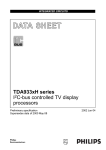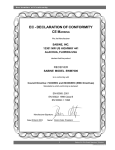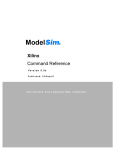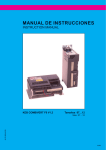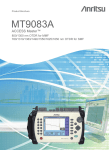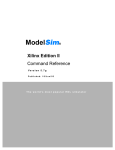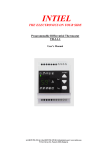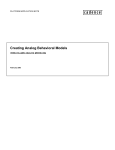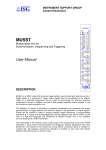Download Manual
Transcript
Model 745 DIGITAL DELAY/PULSE GENERATOR USER MANUAL Ver. 4.0 (Nov. 2013) The Model 745 Four high resolution delay channels 0.25ps delay resolution <25ps RMS jitter max (5ps for short delay) 20s delay range (relative/absolute reference) Three trigger sources: external, internal or command Positive or Negative trigger slope Single, Repetitive or Burst trigger mode Gate mode Tunable output (magnitude 2-5V, width 100ns-10µs) 50 Ω load T0 reference output Ethernet interface (Web page) Options: 4 auxiliary high resolution delay channels (1.25ns, 2 to 5V Amplitude but common tuning) Clock output Gate input High precision internal clock (OCXO 50ppb) The MOD745 digital delay generator provides four independent high resolution digital delay channels. The rms jitter between the trigger and any outputs is 25ps + -7 delay x 10 max. which ensures a high performance delay. The device can be triggered by different ways: External trigger via a BNC input, Internal trigger and Software command trigger, each one with repetitive, single and burst trigger modes. Model 745 Digital Delay Generator. 2013February 14 CONTENT 1- GENERAL INFORMATION .................................................................................................... 4 What do you need to get started ....................................................................................................... 5 Unpacking Caution .......................................................................................................................... 5 Operating temperature ..................................................................................................................... 5 Self-test ............................................................................................................................................. 5 The device software .......................................................................................................................... 5 Power fuses ...................................................................................................................................... 5 RAM with battery back up ................................................................................................................ 5 2- SPECIFICATIONS .................................................................................................................... 6 3- FRONT PANEL OVERVIEW .................................................................................................. 7 LCD screen ...................................................................................................................................... 7 Keypad ............................................................................................................................................. 7 BNCs ................................................................................................................................................ 7 LED indicators ................................................................................................................................. 7 4- REAR PANEL OVERVIEW..................................................................................................... 8 Power Switch.................................................................................................................................... 8 Optional BNCs ................................................................................................................................. 8 Ethernet Port .................................................................................................................................... 8 USB Port (Option) ........................................................................................................................... 8 5- MENU STRUCTURE (NAVIGATING THE MOD745) ........................................................ 9 6- OPERATING INFORMATION ............................................................................................. 12 Operating Principles ...................................................................................................................... 12 Timing principle using external trigger ......................................................................................... 14 Timing principle using internal trigger.......................................................................................... 16 Timing principle using Burst mode ................................................................................................ 17 7- OPERATING EXAMPLE ....................................................................................................... 18 Default value .................................................................................................................................. 18 Initial setup .................................................................................................................................... 18 Setting up the instrument (Recurrent mode) .................................................................................. 18 Setting up the instrument (Single shot mode) ................................................................................. 19 Setting up the instrument (Burst Mode) ......................................................................................... 19 Stop the generator .......................................................................................................................... 19 8- PROGRAMMING.................................................................................................................... 20 Ethernet connection/communication .............................................................................................. 20 Web Page control/communication ................................................................................................. 27 9- ANNEX A .................................................................................................................................. 28 10- ANNEX B .................................................................................................................................. 30 © Berkeley Nucleonics Corp. 2 Model 745 User Manual Model 745 Digital Delay Generator. 2013February 14 EDITION Ed. Date Description 1 02/06/2011 Creation 2 06/04/2012 Modification 3 29/07/2013 Modification (new functions) 4 11/12/2013 Modification (reviewed by J.L.) © Berkeley Nucleonics Corp. 3 Model 745 User Manual Model 745 Digital Delay Generator. 2013February 14 1- GENERAL INFORMATION The MOD745 device provides four high precision independent delay channels. Access to these four outputs (T1-T4) is given by four BNC connectors on the front panel. The achieved delay resolution is about 0.25ps, and trigger-to-channel jitter is less than 25ps (Annex B). T1-T4 can deliver up to 5V, 2ns rise time max (Annex A), into 50Ω. Amplitude and width are adjustable on each output channel either programmed from the front panel or via Ethernet. A T0 output pulse is also available. It gives a time reference for each generated delayed output. This high accuracy and precision device is suitable for system/experiment in science or industry that requires reliable timing solution. The MOD745 also provides four optional delay channels to rear panel T5 to T8 with also a delay resolution of 1.25ns, trigger-to-channel jitter less than 50ps with a common 2 to 5V tunable amplitude. The internal timebase reference is a TCXO with a stability of 0.5ppm. An optional OCXO with a 50ppb precision can replace the standard one. The device offers three operating trigger modes, repetitive (internal or external source), single shot (internal, external or asynchronous source) and a burst mode (internal, external or asynchronous source). A Web page (accessed via Ethernet link) provides a simple method to configure the settings for each channel, amplitude, width, trigger source, trigger mode and to control operation. You can save and recall settings. Instrument Options 745-4C Standard device 745-8C Extension to 8 channels (4 optional channels with 1.25ns resolution) C Clock output G Gate input O OCXO 50ppb Package Contents The box you receive should contain the following: - MOD745 Digital Delay Generator - CD containing the PDF user manual and Labview driver. - Certificate of calibration BNC product: For more information about BNC product see our web site: http://www.berkeleynucleonics.com/. © Berkeley Nucleonics Corp. 4 Model 745 User Manual Model 745 Digital Delay Generator. November 2013 What do you need to get started To set up and use the MOD745, you need the following items: • MOD745 Digital Delay Generator, • MOD745 User Manual Unpacking Caution The MOD745 is shipped in an antistatic package to prevent electrostatic damage to the device. Electrostatic discharge (ESD) can damage several components on the device. Remove the device from the package and inspect the device for loose components or any sign of damage. Notify BNC if the device appears damaged in any way. Caution: Before device plug in, be sure to set the right voltage with the line voltage selector. It operates from 90V to 240 V. Do not apply any voltage to either the shields or the output BNCs. Operating temperature The MOD745 can be operated where the ambient air temperature is 10°C to 35°C and can be stored in ambient temperature from - 10°C to + 60°C. The MOD745 is cooled by air circulation. Self-test The unit model, firmware version, serial numbers and the result of self-test procedure will be displayed one minute after power on. After 30s if the test is good then “self-test” disappears and the device can be used. If the test is not ok then “self-test” stays displayed and the device is locked. The device software Labview Vi’s are provided with the MOD745 device. They allow users to control and/or configure the equipment as planned. These Vis can be integrated in a top-level Vi where several devices are controlled. The communication is done with an Ethernet connection. Power fuses The MOD745 is protected against short circuit by means of one fuse according to nameplate of the power supply (F2.5H250V). RAM with battery back up The MOD745 has a RAM with battery backup in which settings of the instrument can be stored (Lithium battery ref 2032). © Berkeley Nucleonics Corp. 5 Model 745 User Manual Model 745 Digital Delay Generator. November 2013 2- SPECIFICATIONS Clock Input Delays Channels 4 independent delay outputs Range 0 to 20 seconds Resolution 0.25 ps Jitter Frequency User Memory -7 25ps RMS + delay x 10 (external trigger to any output) Annex B -7 Up to 4 sets of MOD745 parametes can be stored/recalled via Front Panel or Telnet 20ps RMS + delay x 10 (Channel to channel) Annex B General specifications < 5ps RMS for short delay (Channel to channel) Size 215 x 245 x 135 mm Power 50 W – 110 to 240 V Orange: Trigger on Accuracy < 250ps + delay x 10 LEDs Time base 200 MHz, 0.5 ppm Software -7 Trigger source Internal 2 Timers tunable in Hz or ns 1Hz to 1MHz, 1Hz resolution 1µs to 4s, 5ns resolution External Control panel Web page from embedded web server for IE, Firefox or Chrome Options 745-8C: 4-auxiliary delay output extension Delay Repetition rate < 1MHz Channels: 4 independent delay outputs 16 Prescaler : 1 to 2 -1 Trigger level, from 0.1 to 5V, Internal load: 50Ω Range: 0 to 20 seconds Resolution: -7 Minimum trigger delay < 60ns Trigger mode (External trigger to any output) -7 Accuracy: < 1ns + delay x 10 Output (Annex A) Single, repetitive or burst Amplitude: 2 to 5V 16 Pulse number: 2 to 2 -1 Width: 100 ns to 10ms; 5ns resolution Period: 1000ns to 1s Load: 50Ω Gate Mode Rise and Fall time < 5 ns 2 settings: General or Individual Gate source Active high, Rep rate <100kHz Connector: BNC on rear panel -C: Clock output (10MHz, +/- 1 V, square) Output T1 to T4 (Annex A) -G: Gate input Amplitude 2 to 5V, 0.1V resolution -O: OCXO 50ppb Width 100ns to 10 µs, 5 ns resolution Load 50 Ω Rise time < 2ns max, 900ps typical Fall time < 5ns max, 2ns typical Connector BNC © Berkeley Nucleonics Corp. 1.25ns Jitter: 50ps RMS + delay x 10 Positive or negative slope Burst specs. 10 or 80 MHz, 50% duty cycle. Ask factory for custom clock frequency. 6 Model 745 User Manual Model 745 Digital Delay Generator. November 2013 3- FRONT PANEL OVERVIEW The Model 745 front panel is composed of several kinds of elements: the user interface which consists of a keypad and an LCD display that allows the user to program various settings and to interact with the device in local mode, 4 status LEDs, 5 BNC connectors. Comment [JL1]: Figure - 1. Front panel LCD screen A 2 line x 20 character module displays parameters for programming operations and status information. Keypad A six touch keypad provides access to the configuration menu: - ▲▼ are used to select the line/function to display. After a press on the ‘OK’ button, up/down increments/decrements digit at the current cursor location - ◄► are used to move the cursor position among digits - Ok sets Sub-Menu and ‘cursor mode’, or if this mode is already set, it stores the current value and clear the cursor mode. Transition from Menu item to Sub-Menu item. - Esc clears the cursor mode without storing any value, gets out from the Sub-Menu item or run/stop a channel pulse generation. BNC Connectors One Trigger Input and 4 independent output channels are available. The output voltage is tunable from 2 to 5V for each output independently and each one has to be terminated in 50Ω. The input Trigger BNC connector provides a trigger signal operating up to 50 kHz. Status LED indicators One status LED by output channel, each LED blinking at the output pulse frequency. © Berkeley Nucleonics Corp. 7 Model 745 User Manual Model 745 Digital Delay Generator. November 2013 4- REAR PANEL OVERVIEW All optional output connectors/modules appear on that side of the device. The other features are listed below. Figure - 2. Rear panel Power Switch The unit is turned on by depressing the Power button. The MOD745 can be operated from 100 to 240V at a line frequency of 50-60Hz. Optional BNCs Clock input and clock output connectors are available. The CLK IN connector accepts either 10MHz or 80MHz (or custom frequency) clock frequency. The optional clock output (CLK OUT) comes from the CLK IN connector or from the internal oscillator – if clock in signal not present. The four optional output (T5 – T8) connectors are 50Ω impedance with adjustable amplitude, delay and width. Ethernet Port A RJ45 Ethernet connector is available to control the Model 745 with a computer. See Chapter 8 – Programming for command syntax. USB Port (Option) A female USB connector can be available allowing computer communication with the MOD745. © Berkeley Nucleonics Corp. 8 Model 745 User Manual Model 745 Digital Delay Generator. November 2013 5- MENU STRUCTURE (NAVIGATING THE MOD745) A three level Menu is available: • A Menu to display settings • Sub-Menus to select parameters to set • A Cursor-Mode to modify selected parameter Without option Here is given a presentation of the display menu for a standard 8 Channel Unit. MENU Menu n° 1 2 3 4 5 6 7 8 9 10 11 12 13 14 15 16 17 18 19 20 Displayed name MOD745 XXXX Gate Mode T0 Clock In T1 T2 T3 T4 T5 (optional) T6 (optional) T7 (optional) T8 (optional) REF GATE Trig Ext Freq/Period 1 Freq/Period2 Burst Settings Trigger 21 22 Store/Recall Status Description Reference of the unit: name, serial number and software reference. General state Setting of Gate mode Settings of T0 channel: trigger, output pulse amplitude and Width Input clock setting: 10 or 80MHz. T1 channel settings: trigger, amplitude, width, delay, reference, gate T2 channel settings: trigger, amplitude, width, delay, reference, gate T3 channel settings: trigger, amplitude, width, delay, reference, gate T4 channel settings: trigger, amplitude, width, delay, reference, gate T5 channel settings: trigger, amplitude, width, delay, reference, gate T6 channel settings: trigger, amplitude, width, delay, reference, gate T7 channel settings: trigger, amplitude, width, delay, reference, gate T8 channel settings: trigger, amplitude, width, delay, reference, gate Dealy reference summary: absolute (T0) or relative (Tx) reference Gate setting summary External trigger settings: threshold value, polarity and prescaler value Frequency or Period of internal trigger generator 1. Frequency or Period of internal trigger generator 2 Burst mode settings Manual trigger (to launch single shot triggers: SS1, SS2, SSE or LSS trigger source) To store/recall up to 4 personal MOD745 configuration Display trigger status of channels (‘*’ appears when the channel is active) Under item #2 we get information about the clock used by the device and device errors that could occur such as PLL or Oscillator error. Under item #3 we get the following sub-menu Gate Mode SUB-MENU Displayed name Gate Mode Description and settings RETURN MENU To return to main menu To select the Gate mode General gate: to inhibit every outputs Channel gate: to set individual behavior for each channels (independent Gate modes set in each Tx sub-menu) When items #4 (T0) and #6 to 13 (T1 to T8) are displayed, the ESC button allows the user to launch Single Shot triggers – if selected – for the current channel. © Berkeley Nucleonics Corp. 9 Model 745 User Manual Model 745 Digital Delay Generator. November 2013 Under item #4 and #6 to #13 we get the following sub-menu: T0-T8 SUB-MENU Displayed name TX TRIG= TX RET= TX Delay= TX Ampl= TX Width= TX Gate RETURN MENU Description and settings To select Trigger source OFF= Trigger signal is inhibited IN1= Trigger signal coming from internal frequency 1 IN2= Trigger signal coming from internal frequency 2 EXT= Trigger signal coming from the front panel (TRIG IN) SS1= Single Shot trigger synchronous with internal freq. 1 SS2 = Single Shot trigger synchronous with internal freq. 2 SSE= Single Shot trigger synchronous with trigger input LSS = Software Single Shot trigger (launched by item #20 or ESC button when Tx displayed) BST = Pulse train Trigger sync. With internal freq. or trigger input To select the channel delay reference: T0 to T8 To adjust Output pulse delay of channel T1 to T8 (1ps resolution display). To adjust Output pulse amplitude of channel T1 to T8. To adjust Output pulse width of channel TX To set Channel Gate mode On or Off (available if general Gate mode is set to “Channel Gate”) of Channel T1 to T8 To Return to main menu Note: T0 doesn’t allow Delay changes. It allows the user to configure each output pulse by selecting its amplitude, width and trigger source. Internal and External sources cannot be set at the same time for two different channels. Note: An output delay with 0.25ps resolution can only be configured by telnet command or via the web page. Channel N° Trigger source Output pulse amplitude width delay Comment [JL2]: newer image recommended Figure - 3. T1 item example With standard 4 channel unit The item #10, 11, 12 and 13 will be skipped and will not be displayed. Item #14 displays a summary of each channel delay reference setting (e.g. for Channel T1: T0 for absolute reference and T2 to T8 for relative reference). The channel delay reference is set in its specific setting menu. Item #15 displays a summary of the channel gate state (‘1’ active and ‘0’ inactive). Under item #16 we get the following sub-menu allowing users to configure the external trigger: © Berkeley Nucleonics Corp. 10 Model 745 User Manual Model 745 Digital Delay Generator. November 2013 Trigger SUB-MENU Displayed name Polarity Threshold Prescaler RETURN MENU Description and settings To To To To trig on rising edge or on falling edge value of the Trig Ext input adjust the threshold value of the Trig Ext input prescale the Trig Ext input frequency by a factor N (N = 1 to 216-1) return to main menu Item #17 and 18 are specific items: setting of frequency or period is available for each internal source (use right or left arrow button to access one or the other). The period setting provides a resolution of 5ns and the frequency setting a resolution of 1Hz. By pressing the ESC button, the user can restart internal frequencies when item 17 or 18 is displayed. Under item #19 we get the following sub-menu Burst Mode SUB-MENU Displayed name Burst Trigger Pulse Number Pulse Period RETURN MENU Description and settings To To To To select the trigger source : Int, Ext or manual select the pulse number in each burst to generate (from 2 to 216-1) select the period between burst pulses (from 1000ns to 1s) return to main menu Under item #21 we get the following sub-menu allowing users to store/recall MOD745 parameters: Store/Recall SUB-MENU Displayed name Store x Recall x RETURN MENU Description and settings To store current MOD745 configuration in conf x (x=0 to 3) To recall conf x MOD745 configuration To return to main menu To refresh the channel status (item #22), a press on the OK button is needed. IP Address SUB-MENU The IP configuration menu can be accessed by a double press OK button on Main menu item #1. Displayed name IP ADRESS NET MASK GATEWAY ADRESS USE DHCP LANGUAGE RETURN MENU Description and settings Set the instrument’s IP address Set the instrument’s IP mask Set the instrument’s IP gateway YES (automatic IP address assignment) or NO (for manual IP assignment) Select French or English language for menu To Return to main menu © Berkeley Nucleonics Corp. 11 Model 745 User Manual Model 745 Digital Delay Generator. November 2013 6- OPERATING INFORMATION Operating Principles The principle of the programmable delay generator is described in the figure 4 below: Figure - 4. Principle Trigger source can be provided by the TRIG IN input, by an internal trigger, by a software command trigger. Repetitive, single shot trigger and burst modes are available with internal and external sources. An asynchronous single shot and burst mode are also available. Repetitive triggers When the external trigger source is selected a rising edge on “TRIG IN” starts a delay sequence. The sequence is depicted on Figure - 6. It has to be noticed that a Prescaler value can be used to divide the Trig Ext input signal frequency. To get this feature, the user has to select ‘EXT’ as trigger source on the device via the front panel or via remote control (web page, Ethernet link). If the internal trigger source is selected, the user can specify the needed trigger source via the front panel or via remote control (web page, Ethernet link). 2 frequency generators derived from input clock can be used as repetitive triggers: IN1 and IN2 corresponding to programmable Frequency 1 and 2. The use of internal trigger is depicted on Figure - 8. Frequency generation restarts when a push on the ESC button is detected while Frequency/Period menu is displayed. Note: The internal period P1 et P2 can only be increment by step of 5ns. Single Shot triggers 3 single shot modes are available: one synchronous to the external source (SSE), one to an internal source (SS1 synchronous to Frequency 1, SS2 synchronous to Frequency 2) and the last, an asynchronous one (LSS). Each single shot mode is triggered by a software command. Software trigger command is available either via remote control or via front panel (by pressing ESC button when items #6 to 13 are displayed or by using item #20). Single shots synchronous to external source is depicted on Figure - 6. The same principle can be applied to any of the internal sources. © Berkeley Nucleonics Corp. 12 Model 745 User Manual Model 745 Digital Delay Generator. November 2013 Burst mode The Burst mode is defined by its trigger source (internal, external, software / single shot or repetitive), its pulse number in each burst and the period between pulses. A pulse train can be independently set and defined on each channel: amplitude, width and delay are defined in the corresponding channel menu. An example of Burst mode is depicted on Figure - 9. To generate a burst on a specified channel, first, the user has to configure the Burst mode itself (trigger, pulse number and pulse period) and then select “Burst (BST)” in the trigger source selection of the concerned channel. Output channels A T0 output pulse is the time reference of the delay output. It is generated for each selected trigger. Each output delayed pulse values T1 to T4 can be independently tuned in level, absolute or relative delay and width. All values (delay, delay reference, level, width, gate) are saved in memory except the trigger source. Each output delayed pulse values (T5 to T8) can be independently tuned in absolute or relative delay and width. All values (delay, delay reference, width) are saved in memory except the trigger source. Calibration parameters are saved onboard. After the power on, all trigger sources are off. It has to be noticed that several output channels can only be triggered by the same source, that is to say an internal OR external source. Gate mode Each channel can be independently or simultaneously inhibited by the Gate in input signal. A Gate menu is available in the main menu of the MOD745 device and in each Tx sub-menu. 2 different modes can be selected in the general Gate menu: • 1 “GENERAL” mode to inhibit simultaneously all channels, • 1 “CHANNEL” mode to inhibit independently each channel by setting in each Tx sub-menu the desired Gate state (‘1’ active, ‘0’ inactive). Configuration summary On Figure - 5 is presented a functional diagram of the device. The different operation modes are illustrated. Figure - 5. © Berkeley Nucleonics Corp. 13 Functional Diagram Model 745 User Manual Model 745 Digital Delay Generator. November 2013 Timing principle using external trigger When the device is in a rest state (no current output signals), a rising edge on a trigger starts a delay sequence. The trigger comes from TRIG IN, or from a software command trigger (depending on the selected channel source). The sequence includes two external trigger phases: • After an insertion delay (<60ns), a pulse appears on each channel after a specified delay • At the end of sequence, after the last delayed pulse, the delay generator is ready for repetitive trigger mode. When a sequence is in progress, the instrument does not respond to a trigger event. The MOD745 must be configured (trigger, delay, etc.) before starting any sequences. Figure - 6. External Trigger Timing In response to an input pulse the board can generate a single delayed output (single shot) or repetitive delayed output (repetitive mode with a Trig In prescaler value = 1). As explain before, the single shot pulse is conditioned by the soft trigger command. The use of the Prescaler value is depicted on Figure - 7. T1 Channel trigger source is set to external trigger. © Berkeley Nucleonics Corp. 14 Model 745 User Manual Model 745 Digital Delay Generator. November 2013 Figure - 7. © Berkeley Nucleonics Corp. 15 Prescaler value Model 745 User Manual Model 745 Digital Delay Generator. November 2013 Timing principle using internal trigger Figure - 8. Internal Trigger Timing In Internal trigger mode, two tunable frequencies are available (IN1 and IN2). On Figure - 8, T1 output uses IN1 trigger with a specified delay of 0ps and T2 output uses IN2 trigger with a non-null delay. The MOD745 must be configured (trigger, delay, etc.) before starting any sequences. The individual Channel Gate Mode is also depicted on Figure - 8. It is obtained by setting general Gate Mode to “CHANNEL” and T1 Gate mode to “ON”. The result is that the Gate In signal inhibits the trigger source of the channel T1, that is to say IN1 in that case. The width parameter doesn’t appear on these two Figures (Figure - 6, Figure - 8). It has to be noticed that the frequency f used as repetitive input trigger (internal or external) and the maximum width of a corresponding output channel TX are linked by: 𝑴𝒂𝒙𝑾𝒊𝒅𝒕𝒉 𝑻𝑿 = © Berkeley Nucleonics Corp. 16 𝟏 𝟒𝒇 Model 745 User Manual Model 745 Digital Delay Generator. November 2013 Timing principle using Burst mode Each Channel can be independently set to Burst mode. In the following example Burst trigger has been set to IN1, Burst pulse number to 5 and Burst period to TB Figure - 9. Burst Mode Timing The minimal burst period value is 1000ns. But it has to be noticed that this value depends on the Burst trigger period value and on the Burst pulse number. 𝑻𝑩𝒎𝒊𝒏 = 𝑻𝒕𝒓𝒊𝒈𝒈𝒆𝒓 𝒎𝒊𝒏 𝟐 ∗ 𝑷𝒖𝒍𝒔𝒆 𝑵𝒃𝒓 So, to get a TBmin = 1000ns we have to configure the device as follows: • TTrigger min = Pulse nbr * 2000ns • Pulse nbr min = 2 • Ttrigger min = 4000ns As depicted on Figure - 9, in the case of a generation of pulse train (Burst Mode) on a channel, the Gate In signal can inhibit some pulses among the pulse train. © Berkeley Nucleonics Corp. 17 Model 745 User Manual Model 745 Digital Delay Generator. November 2013 7- OPERATING EXAMPLE Default value These values are the one stored by default: • IP: 99.0.0.18 • Gateway: 99.0.0.01 • NetMask: 255.0.0.0 • Frequency1: 1000Hz • Frequency2: 1000Hz • TX Level: 5V, Width: 200ns. Initial setup Turn on the Model 745 with the rear panel power switch. After 30 seconds, the following information are displayed: MOD745 Sn xxxxx,4 V1 SELF TEST Setting up the instrument (Recurrent mode) The aim is to set a repetitive frequency of 1000Hz to output pulse T1, with an amplitude of 4V and a width of 1µs. Use keys to configure the settings as following (Internal frequency 1 has been set to 1000Hz previously): Button operation Display Start at menu item #1 Up 2 times and press OK T1 Trigger = OFF T1 Ampl 5.00 V T1 Ampl 5.00 V T1 Ampl 5.00 V T1 Ampl 4.00 V T1 Ampl 4.00 V T1 Width 200 ns T1 Width 200 ns T1 Up 1 time Press OK Left 2 times Up 1 time Press OK Up 1 time Press OK Left 3 times Width T1 Width T1 Width T1 Width T1 Width T1 Trigger T1 Trigger T1 Trigger Up 1 time Right 1 time Down 2 times Press OK Up 2 times and press OK Up 1 time Press OK © Berkeley Nucleonics Corp. 18 200 ns 1200 ns 1200 ns 1000 ns 1000 ns = OFF = IN1 = IN1 Model 745 User Manual Model 745 Digital Delay Generator. November 2013 As soon as T1 is set to IN1, the front panel LED of T1 output will be on (In fact, it will blink at the output pulse rate, in that case at INternal frequency 1=1000Hz) indicating that there is an output signal on T1 connector. With an oscilloscope you can check the channel T1. Measurement should be: Rectangular shape with repetitive frequency =1000 Hz, Amplitude= 4.0V, Width = 1.0 µs. Setting up the instrument (Single shot mode) The procedure explained before can be followed up to the trigger choice. 3 single shot modes (external: SSEXT, internal: SS1 and SS2, asynchronous: LSS) can be set. Once the single shot trigger mode is set, the user has to send a software command to trigger the single shot output pulse. To send this software command, 3 ways are available: • Via the front panel: o In the Trigger menu (item #16 of the general menu), by pressing the Ok button o If item #6 to 9 are displayed, by pressing the ESC button • Via a telnet command, by sending the ‘RUN’ command to the device • Via the web page, by pressing the ‘manual trigger’ button in the Trigger menu Setting up the instrument (Burst Mode) The aim is to set channel T1 in Burst mode to get: • a 5V, 200ns width, 0ns delay pulse • 100Hz IN1 trigger source • Burst period 100000ns, pulse number = 10 First the user has to configure the F1 frequency to 100 Hz and then the Burst Mode itself. That is to say, set in the Burst Mode menu (item# 15 in the main menu): • Burst Trigger: IN1 • Burst Period: 100000 • Burst pulse number: 10 Once this has been done, the user has to set the width, delay and trigger source (BURST) in the T1 channel sub-menu. The device will start to generate the requested pulse train. Stop the generator To stop the generation of that repetitive pulse, you have to set T1 trigger to OFF value. This will switch off the corresponding LED. With an oscilloscope you can check if the output signal is switch off. © Berkeley Nucleonics Corp. 19 Model 745 User Manual Model 745 Digital Delay Generator. November 2013 8- PROGRAMMING Ethernet connection/communication Generality For connection over a LAN, you have to do the following: • Connect the instrument to the LAN physically, • In the graphical user interface, specify the LAN address, • On the control PC, enter the instrument’s IP address, • After the connection has been established, the following commands can be used to modify the settings: o Set’s the instrument’s IP address with: IP XXX.XXX.XXX.XXX o Query’s the instrument’s IP address with: IP? ⇒ :IP XXX.XXX.XXX.XXX o Set’s the instrument’s IP mask with: NM XXX.XXX.XXX.XXX o Query’s the instrument’s IP mask with: NM? ⇒ :NM XXX.XXX.XXX.XXX o Set’s the instrument’s IP gateway: GW XXX.XXX.XXX.XXX o Query’s the instrument’s IP gateway with: GW? ⇒ :GW XXX.XXX.XXX.XXX Command structure Each command description is composed at least of some of the following items (all commands are used in a telnet prompt): • Full command syntax, • Form Set / Query, • Brief description, • Parameters, • RST value, • Specified limits. • Example. *IDN? Syntax: Form: Description: Parameter: RST value Example: BURST TRIG Syntax: Form: Description: Parameter: RST value © Berkeley Nucleonics Corp. *IDN? Query Queries instrument identification. Answer gives instrument model, serial number and firmware version. BNC,MODEL 745,53901/F,V1.1 Instrument model: MOD745 Serial number: 53901, Channel number: F => 4 active channels (FF => 8 active channels) Software version: 1.1 BTRIG Source BTRIG? source Set & Query Trigger source for Burst mode: internal, external or local Source: IN1, IN2, EXT, SSL - 20 Model 745 User Manual Model 745 Digital Delay Generator. Example: BURST PULSE PERIOD Syntax: Form: Description: Parameter: RST value Specified limit Example: BURST PULSE NUMBER Syntax: Form: Description: Parameter: RST value Specified limit Example: GENERAL GATE MODE Syntax: Form: Description: Parameter: RST value Example: CHANNEL GATE MODE Syntax: Form: Description: Parameter: RST value Example: RELATIVE DELAY Syntax: © Berkeley Nucleonics Corp. November 2013 Set external trigger source: BTRIG EXT Query: BTRIG? => :BTRIG EXT PERIOD PB, T PERIOD? PB Set & Query Set Burst period PB T: period in ns (5ns resolution) 1000 ns to 1s PERIOD PB, 1000 PERIOD? PB=> :PER 1000 BPULSE N BPULSE? Set & Query Set the number of pulses in a burst N : Number of pulses 2 to 216-1 (depending on trigger source period and Burst period) BPULSE 1000 BPULSE? => :BPULSE 1000 GGLOBAL mode GGLOBAL? Set & Query General Gate mode status mode: OFF, ON and CH Set : inhibit all outputs : GGLOBAL ON Query: GGLOBAL? => :GGLOBAL ON GCHAN Tx, value GCHAN? Tx Set & Query Individual channel Gate mode status Tx: T1 toT 4 (or 1 to 8 for 8 channel) Value: ON, OFF Set : T1 channel mode On : GCHAN T1, ON (GENERAL GATE MODE has to be set to CH to activate this setting) Query: GCHAN? T1 => :GCHAN T1, ON DELAY Tx,Ti, delaytime 21 Model 745 User Manual Model 745 Digital Delay Generator. Form: Description: Parameter: RST value Specified limit Example: November 2013 DELAY? Tx Set & Query Delay time of channel Tx relative to channel Ti (reference channel) is set to delaytime picosecond Tn: channel number 1 to 4 (or 1 to 8 for 8 channel) Ti: channel number 0 to 4 (or 0 to 8 for 8 channel) Tn and Ti have to be different delaytime: picosecond delay 0 to 19 999 999 999 999 picoseconds Set : program 1ns to channel 2 relative to channel 1 : DELAY T2, T1, 1000.75 Query: DELAY? T2 => :DELAY T2, T1, 1000.75 Note : By using the Web page or Telnet command to configure the device, user can specify delay with 0.25ps resolution. ABSOLUTE DELAY Syntax: Form: Description: Parameter: RST value Specified limit Example: TRIG Syntax: Form: Description: Parameter: RST value Example: AMPLITUDE Syntax: Form: Description: Parameter: RST value Specified limit Example: © Berkeley Nucleonics Corp. ABSDELAY? Tx Query Absolute delay time of channel Tx in ps Tx: channel number 1 to 4 (or 1 to 8 for 8 channel) Query: ABSDELAY? T2 => :DELAY T2, 5000.75 TRIG Tx,DEC TRIG? Tx Set & Query Tx trigger mode selection: set trigger mode to internal, external, manual or off. Tx: channel number 1 to 4 (or 1 to 8 for 8 channel) DEC: trigger mode : IN1, IN2, EXT, SS1, SS2, SSE, LSS, BST, OFF off Internal mode to channel 2 : TRIG T2,IN1 Query mode to channel 2: TRIG? T2 => :TRIG T2,IN1 AMPL Tx, mV AMPL? Tx Set & Query Tx channel voltage level setting Tx: channel number 1 to 4 (or 1 to 8 for 8 channel) mV: Volt Amplitude in milliVolt 2000 to 5 000 mV 2.5 V to channel 4: AMPL T4,2500 Query mode to channel 4: AMPL? T4 => :TRIG T4,2500 22 Model 745 User Manual Model 745 Digital Delay Generator. WIDTH Syntax: Form: Description: Parameter: RST value Specified limit Example: EXT TRIG THRESHOLD Syntax: Form: Description: Parameter: RST value Specified limit Example: EXT TRIG POLARITY Syntax: Form: Description: Parameter: RST value Specified limit Example: EXT TRIG PRESCALER Syntax: Form: Description: Parameter: RST value Specified limit Example: FREQUENCY Syntax: Form: © Berkeley Nucleonics Corp. November 2013 WIDTH Tx,W WIDTH? Tx Set & Query Channel Tx width setting Tx: channel number 1 to 4 W: width ns Channel T0 to T4 : 100 to 10 000 ns Channel T5 to T8 : 100 to 10 000 000ns 250 ns to channel 4: WIDTH T4,250 Query mode to channel 4: WIDTH? T4 => :WIDTH T4,250 STRIG mV STRIG? Set & Query Set and Query trigger threshold voltage mV: Threshold level in milliVolt 100 to 5 000 mV 2.5 V: STRIG 2500 Query mode: STRIG? => : 2500 POLAR Edge POLAR? Set & Query Edge: Rising Edge or Falling Edge Edge: R_E or F_E R_E or F_E parameters Falling Edge: POLAR F_E Query mode: POLAR? :F_E TPRESC Value TPRESC?? Set & Query Set prescaler value to divide Trig In source frequency Value: Trig In prescaler value from 1 to 216-1 4: TPRESC 4 Query mode: TPRESC? :4 FREQ Fx, F FREQ? Fx Set & Query 23 Model 745 User Manual Model 745 Digital Delay Generator. Description: Parameter: RST value Specified limit Example: PERIOD Syntax: Form: Description: Parameter: RST value Specified limit Example: CLKEXT Syntax: Form: Description: Parameter: RST value Specified limit Example: RUN STORE RECALL November 2013 Set internal mode frequency Fx : F1, F2 F: frequency Hz 1 Hz to 1 MHz FREQ F1, 1000 FREQ? F1=> :FREQ 1000 PERIOD Px, T PERIOD? Px Set & Query Set internal mode period Px : P1, P2 T: period in ns (5ns resolution) 1000ns to 4s PERIOD P1, 1000 PERIOD? P1=> :PER 1000 CLKEXT F CLKEXT? F Set & Query Set external PLL frequency F: external PLL frequency: CLK10, CLK80 CLKEXT CLK10 CLKEXT? => :CLKEXT: CLK10 Syntax: Form: Description: Parameter: RST value Example: RUN Set Software trigger RUN Syntax: Form: Description: Parameter: RST value Specified limit Example: STORE n Set To store MOD745 current configuration n: configuration number 0 to 3 STORE 1 Syntax: Form: Description: Parameter: RECALL n Set To recall a MOD745 configuration previously stored n: configuration number © Berkeley Nucleonics Corp. 24 Model 745 User Manual Model 745 Digital Delay Generator. STAT November 2013 RST value Specified limit Example: 0 to 3 RECALL 1 Syntax: STAT CLEAR STAT? xxx Set & Query Equipment information CLK: INTERNAL / EXTERNAL TRIG: trigger channel 1 to 4 states PLL: PLL oscillator state OSC: gated oscillator state Off STAT CLEAR : clear the information Form: Description: Parameter: RST value Example: STAT? CLK => :STAT CLK,INTERNAL STAT? TRIG => :STAT TRIG,1,0,0,1 Channel 1 and 4 trig on mode internal, external or manual STAT? PLL => PLL oscillator default, STAT? OSC => gated oscillator default IP address Syntax: Form: Description: Parameter: RST value Example: Net mask address Syntax: Form: Description: Parameter: RST value Example: GW address Syntax: Form: Description: Parameter: RST value Example: © Berkeley Nucleonics Corp. IP x.x.x.x IP? Set & Query IP Adress x.x.x.x : IP address Off IP 172.17.23.6 IP? => :IP 172.17.23.6 NM x.x.x.x NM? Set & Query Net mask Address x.x.x.x : NW address Off NW 255.255.0.0 NW? => :NW 255.255.0.0 GW x.x.x.x GW? Set & Query GW Address x.x.x.x : GW address Off GW 172.17.23.6 GW? => :GW 172.17.23.6 25 Model 745 User Manual Model 745 Digital Delay Generator. November 2013 About Telnet Ports 3 ports can be used to configure the communication link and/or the µcontroller used to communicate. • Port 4000: general communication port • Port 4001: re-initialization communication port. Used to reinitialize the communication between µC and PC. Used in case of frozen device. • Port 4002: force reset the µC. Used in case of frozen device. © Berkeley Nucleonics Corp. 26 Model 745 User Manual Model 745 Digital Delay Generator. November 2013 Web Page control/communication The user can open a web page to control the MOD745 device via Internet Explorer, Firefox or Chrome (last versions supported). To access the web page, the IP address of the device has to be typed in the navigator address field. Once that is done, the user should access to the following page. Figure - 10. Configuration page From that page, the user can configure each output pulse (amplitude, width, trigger, delay, inhibit and delay reference), trigger settings, internal frequencies, external clock and burst mode. On the first setting change, the user will be asked for Login and Password (Default Login: BNC, Default password:bnc). Status LEDs indicate which outputs are active or not and Fault LEDs warn the user in case of errors. To refresh led status, the user has to click on one off these LEDs. The “manual trigger button” is used to trigger a channel sets to SS1, SS2 or LSS (Single shot 1 & 2 and Local Single Shot) And at last, the user can access to the password setting page by typing in the address field: “Device IP/passwd.htm”. Figure - 11. © Berkeley Nucleonics Corp. 27 Password page Model 745 User Manual Model 745 Digital Delay Generator. November 2013 9- ANNEX A High precision and auxiliary pulse results appear on the following figures. Figure - 12. © Berkeley Nucleonics Corp. 28 Main pulse Model 745 User Manual Model 745 Digital Delay Generator. November 2013 Figure - 13. © Berkeley Nucleonics Corp. 29 Auxiliary pulse Model 745 User Manual Model 745 Digital Delay Generator. 10- November 2013 ANNEX B Jitter (ps) The rms jitter for Internal and External source are depicted on figure 11 and 12. It is given for different delay values. 260 240 220 200 180 160 140 120 100 80 60 40 20 0 Internal External 1 100 10000 1000000 100000000 Delay (ns) Figure - 14. Internal and External delay Jitter 30 25 Jitter (ps) 20 15 Internal 10 External 5 0 1 100 10000 1000000 Delay (ns) Figure - 15. © Berkeley Nucleonics Corp. 30 Zoom on delay jitter Model 745 User Manual Model 745 Digital Delay Generator. November 2013 BNC Product Information for People’s Republic of China This document provides product information as required by the People’s Republic of China Electronic Industry Standard SJ/T11364–2006, Marking for Control of Pollution Caused by Electronic Information Products. Table 1 lists toxic or hazardous substances or elements contained in Greenfield Technology electronic information products (EIPs), including subassemblies, that exceed limits specified in SJ/T11363–2006. Table 1. Example Toxic or Hazardous Substances and Elements Contained in Product Component Name Toxic or Hazardous Substances and Elements Lead Mercury Cadmium (Pb) (Hg) (Cd) Hexavalent chromium (Cr6+) Polybrominated biphenyls (PBB) Polybrominated diphenylethers (PBDE) Printed circuit card assembly X O O O O O Metal enclosure X O O X O O O: Indicates that the toxic or hazardous substance contained in all of the homogeneous materials for this part is below the limit required in SJ/T 11363-2006. X: Indicates that the toxic or hazardous substance contained in at least one of the homogeneous materials used for this part is above the limit requirement in SJ/T 11363-2006. Product Marking Explanations In accordance with the requirements specified in SJ/T 11324-2006, all BNC EIPs sold in the People's Republic of China are marked with pollution control marking. The following marking applies to BNC products. This marking indicates that some homogeneous substance within the EIP contains toxic or hazardous substances or elements above the requirements listed in SJ/T11363–2006. These substances are identified in Table 1. The size or function of some products may prevent them from being directly marked. These products still meet SJ/T11364–2006 requirements, and their marking information is covered by this document. Environmentally Friendly Use Period The number in the marking, shown as 40 in the illustration above, refers to the EIP’s environmentally friendly use period (EFUP). The EFUP is the number of years from the date of manufacture that toxic © Berkeley Nucleonics Corp. 31 Model 745 User Manual Model 745 Digital Delay Generator. November 2013 or hazardous substances or elements contained in EIPs will not leak or mutate under the normal operating conditions described in the EIP user documentation, resulting in any environmental pollution, bodily injury, or damage to assets. Original Equipment Manufactured (OEM) EIP SJ/T11364–2006 specifies that OEM EIPs shipped by BNC should include hazardous substance information and EFUP markings. Table 1 applies to products that do not supply OEM product information Manufacture Date Manufacture dates of all BNC products are encoded into the product serial number. Contact your local sales office to obtain the manufacture date for your product. Packaging Recycling Marks EIP packaging is marked in accordance with the needs and requirements for recycling, reuse, and regeneration, as defined in standard GB 18455–2001, Packaging Recycling Marks. As specified in SJ/T11364–2006, the following packaging information may be used for instances in which it is not possible to provide recycling marks on the packaging material. Waste Electrical and Electronic Equipment (WEEE) EU Customers At the end of the product life cycle, all products must be sent to a WEEE recycling center. © Berkeley Nucleonics Corp. 32 Model 745 User Manual

































